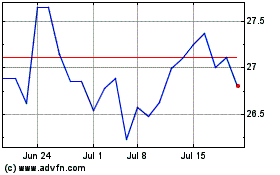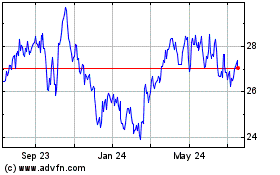By Jonathan Randles
A pension fund covering about 90,000 coal workers and their
families is on the brink of insolvency while hundreds of these
miners also face losing medical benefits, part of mounting
financial stress on the larger safety net meant to protect sick or
out-of-work miners.
The United Mine Workers of America multiemployer pension plan is
projected to become insolvent during its 2022 plan year if Congress
doesn't authorize using public funds to buttress it for the first
time in a history tracing back more than 70 years. Murray Energy,
which filed for bankruptcy Tuesday, is the last major contributor
to the fund.
Large U.S. coal producers have used bankruptcy as a tool to
survive the industry's decadelong decline. Several companies have
successfully argued in chapter 11 that they must walk away from
pension and medical obligations to stay in business, keep mines
open and save jobs, according to court records, testimony and
interviews.
Since last October, at least eight coal companies employing
nearly 16,000 union and nonunion workers have filed for bankruptcy
protection.
The bankruptcies have coincided with a decline in the U.S. coal
market, which has grappled with environmental regulations during
the Obama administration and competition from alternative fuel
sources such as natural gas and renewable energy.
A Growing Shortfall
The use of chapter 11 has nearly eliminated coal company
contributions to the plan. During the 2018 plan year, the pension
fund collected $30 million in employer contributions, dwarfing its
$613.8 million in benefit payments. The fund's assets were valued
at about $2.4 billion, compared with $6.6 billion in liabilities.
For every active worker, the plan supports roughly 28 retirees,
UMWA Health and Retirement Funds Executive Director Lorraine Lewis
told House lawmakers in July.
The multiemployer pension plan was 38% funded, Ms. Lewis said at
the time, a significant fall from 2008, when the plan was 93%
funded before the financial crisis.
If the plan fails, it would likely mean cuts to monthly benefit
payments that average $596 for all pensioners and $368 for
surviving spouses. More than half of pensioners get less than $500
a month.
"Chapter 11 has clearly been used, by the coal industry at
least, as a convenient way for people to get out of living up to
their obligations," UMWA spokesman Phil Smith said.
Mining companies also have used chapter 11 powers to avoid the
costs that come with withdrawing from the pension plan. For
instance, Patriot Coal Corp, Alpha Natural Resources, Jim Walter
Resources and Mission Coal Corp. -- all of which have filed for
bankruptcy since 2012 -- have avoided paying nearly $4 billion in
combined withdrawal liabilities, according to Ms. Lewis's
testimony.
Murray Energy said in court papers Tuesday it paid about $15
million into the pension fund in 2018 and as a result of the
previous bankruptcies faces liabilities upward of $6.4 billion if
it withdraws from the plan. A restructuring support agreement
backed by Murray's senior lenders calls on the company to negotiate
modifications to its retiree benefits and reject collective
bargaining agreements.
The UMWA said Tuesday: "Our retirees should understand that
their health care will continue to be paid, at least until the
bankruptcy process is completed."
Seeking Solutions
The decline of the pension plan has prompted Congress to
consider remedies. The UMWA is lobbying Senate Majority Leader
Mitch McConnell (R., Ky.) to take up legislative proposals that
would send excess funds from an abandoned mine reclamation fund to
the pension plan. Mr. McConnell's spokesman said he "is concerned
about the insolvency issues facing a number of multiemployer
pension plans and he supports the ongoing process to find a
bipartisan solution for pension reform."
The Pension Benefit Guaranty Corp., the U.S. government's
pension insurer, would step in if the UMWA pension plan goes
insolvent. PBGC Director Gordon Hartogensis said the miners' plan
is one of roughly 125 multiemployer pension plans expected to run
out of money in the next 20 years, affecting nearly 1.4 million
people. The PBGC has said its multiemployer pension program could
itself run out of money by 2025.
Recent bankruptcies also have put medical benefits for hundreds
of retirees who worked at Mission Coal Co. and Westmoreland Coal
Co. in jeopardy. Former coal miners who spoke with The Wall Street
Journal said they agreed to do hazardous mine work because they
were promised a pension as well as medical benefits for after they
retired.
"You put your life at risk every day you go underground. You
don't know if you're going to make it out or not," said
Westmoreland retiree Gary Wells, 76 years old. "You put your health
and everything at risk for the company."
Westmoreland retirees and their dependents are expected to lose
medical benefits by year's end if Congress doesn't add them to a
UMWA health plan. The company's bankruptcy advisers said such a
plan was needed to avert liquidation and preserve jobs. Lenders
that took over Westmoreland provided $6 million to fund retiree
benefits temporarily.
Westmoreland retiree Bethel Brock, 79, said he has been notified
that he could lose medical benefits for himself and his wife at the
end of the year. Mr. Brock said he has been diagnosed with a
complicated form of black lung disease and relies on the
Westmoreland benefits, UMWA pension, Medicare and Social Security.
Westmoreland withdrew from the UMWA pension plan in 2004.
"When a coal company is through with you, you're just like a
used piece of equipment," Mr. Brock said.
Black Lung Resurgence
Since 2014, coal bankruptcies also have transferred more than
$310 million in corporate liabilities to the federal Black Lung
Disability Trust Fund, which compensates workers diagnosed with
black lung disease. The shift has come as researchers have
documented a resurgence of a severe form of the disease in
Appalachia.
"Our clients are younger and sicker than ever before," said
Rebecca Shelton, coordinator of policy and organizing at the
nonprofit Appalachian Citizens Law Center, which helps workers
seeking black lung benefits.
An excise tax to fund this trust fund was scaled back at the end
of last year because of Congress inaction, meaning the fund likely
will need to borrow more public funds to continue providing
benefits. A former miner could get between $660 and $1,320 in
monthly black lung benefit payments depending on the number of
their dependents, according to the Government Accountability
Office.
"A lot of people that are drawing black lung [benefits], they're
struggling to pay their bills," said Patty Amburgey, a member of a
black lung association in southeast Kentucky who lost her husband
to the disease.
Sen. Joe Manchin (D., W.Va.) has been a lead sponsor on proposed
legislation that would add affected retirees of Westmoreland and
Mission Coal to a UMWA health plan, direct excess reclamation funds
to the pension plan and restore the higher black lung excise tax.
That bill, introduced in January by Democrats, is co-sponsored by
presidential candidates Bernie Sanders, Elizabeth Warren and Kamala
Harris.
Write to Jonathan Randles at jonathan.randles@wsj.com
(END) Dow Jones Newswires
October 30, 2019 05:44 ET (09:44 GMT)
Copyright (c) 2019 Dow Jones & Company, Inc.
Coterra Energy (NYSE:CTRA)
Historical Stock Chart
From Mar 2024 to Apr 2024

Coterra Energy (NYSE:CTRA)
Historical Stock Chart
From Apr 2023 to Apr 2024
